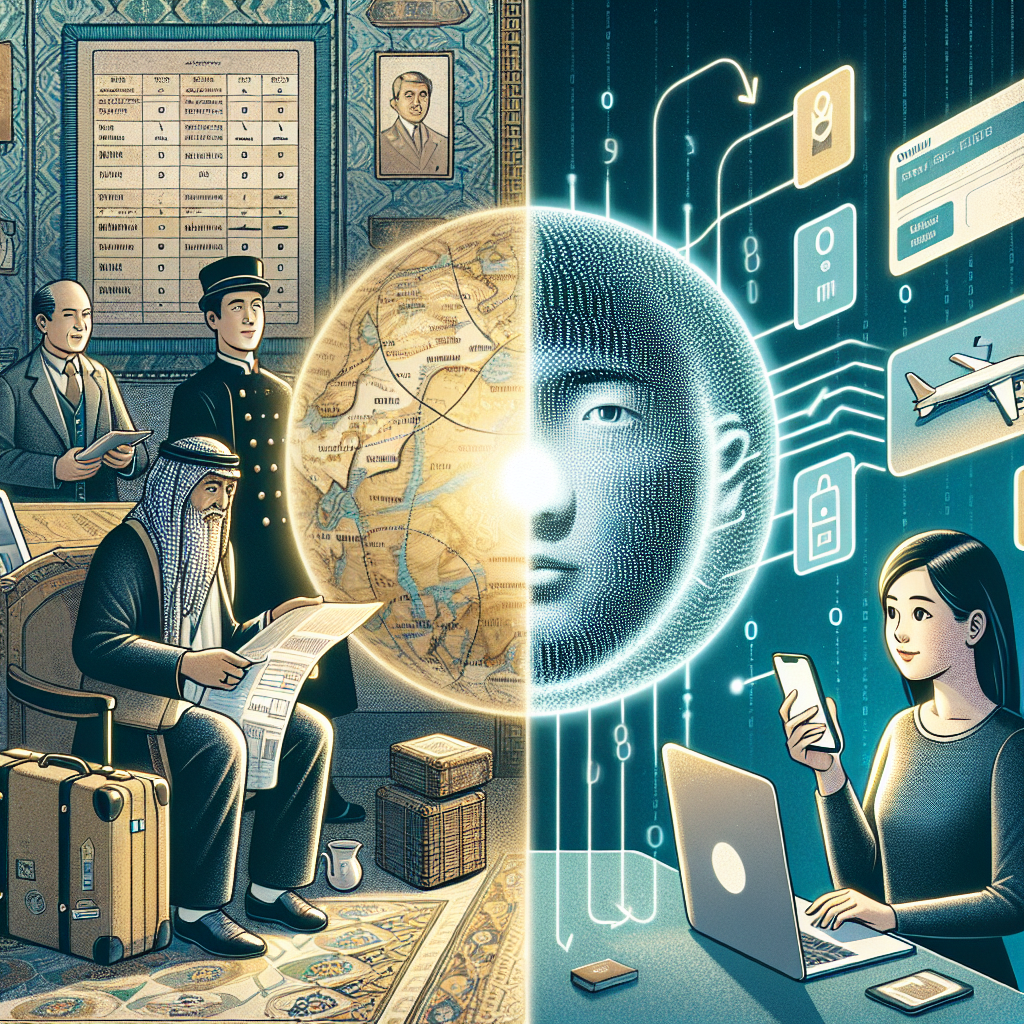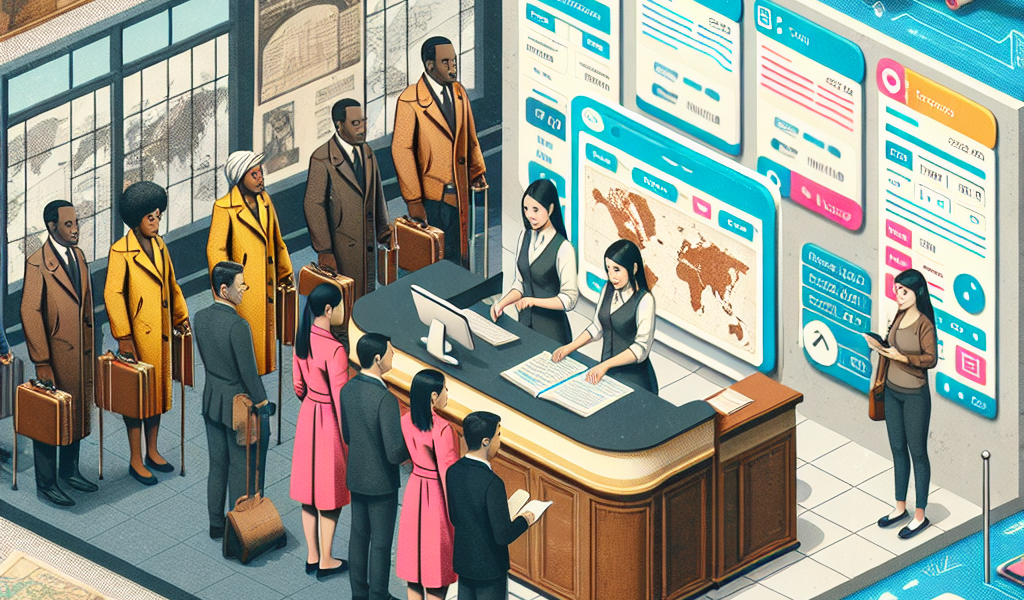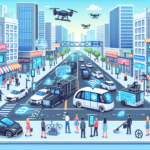-
Table of Contents
“Revolutionizing Journeys: The Digital Transformation of Travel”
Introduction

Technology is revolutionizing the travel industry by enhancing the way people plan, book, and experience their journeys. From the advent of online booking platforms and mobile apps to the integration of artificial intelligence and virtual reality, technological advancements are making travel more accessible, personalized, and efficient. Innovations such as smart luggage, digital payment systems, and real-time language translation tools are streamlining the travel process, while data analytics and machine learning are enabling companies to offer tailored recommendations and improved customer service. As technology continues to evolve, it is reshaping the travel landscape, creating new opportunities for both travelers and industry stakeholders.
Smart Airports: Enhancing Passenger Experience Through Technology
In recent years, the travel industry has undergone a significant transformation, largely driven by advancements in technology. One of the most notable areas where this change is evident is in the development of smart airports. These technologically advanced hubs are revolutionizing the way passengers experience air travel, making it more efficient, convenient, and enjoyable.
To begin with, the implementation of biometric technology has streamlined the check-in and boarding processes. Gone are the days of long queues and cumbersome paperwork. Instead, passengers can now use facial recognition systems to swiftly move through various checkpoints. This not only speeds up the process but also enhances security, as biometric data is more difficult to forge compared to traditional identification methods. Consequently, travelers can spend less time waiting and more time enjoying their journey.
Moreover, smart airports are leveraging the power of the Internet of Things (IoT) to create a more connected and responsive environment. For instance, sensors placed throughout the airport can monitor everything from air quality to crowd density. This data is then used to optimize various aspects of airport operations. For example, if a particular area becomes overcrowded, the system can automatically redirect passengers to less congested zones, thereby improving the overall flow of foot traffic. Additionally, IoT-enabled luggage tags allow passengers to track their bags in real-time, reducing the anxiety associated with lost or delayed luggage.
In addition to these innovations, artificial intelligence (AI) is playing a crucial role in enhancing the passenger experience. AI-powered chatbots and virtual assistants are now commonplace in many smart airports, providing travelers with instant access to information and support. Whether it’s finding the nearest restroom, checking flight status, or getting restaurant recommendations, these digital assistants are available 24/7 to help. This not only improves customer satisfaction but also frees up human staff to focus on more complex tasks.
Furthermore, the integration of mobile technology has made navigating airports easier than ever before. Many smart airports offer dedicated mobile apps that provide a wealth of information at passengers’ fingertips. From interactive maps to personalized notifications about gate changes and boarding times, these apps are designed to make the travel experience as seamless as possible. Some even offer augmented reality (AR) features, allowing travelers to use their smartphones to find their way around the airport with ease.
Another significant advancement is the use of automated systems for various services. Self-service kiosks for check-in, baggage drop, and even food ordering are becoming increasingly common. These systems not only reduce wait times but also minimize human contact, which has become particularly important in the wake of the COVID-19 pandemic. By reducing the need for face-to-face interactions, smart airports are helping to create a safer and more hygienic travel environment.
Lastly, sustainability is a key focus for many smart airports. Advanced energy management systems are being implemented to reduce the environmental impact of airport operations. From solar panels to energy-efficient lighting and HVAC systems, these technologies are helping airports become more eco-friendly. Additionally, some airports are exploring the use of electric and autonomous vehicles for ground transportation, further reducing their carbon footprint.
In conclusion, the advent of smart airports is transforming the travel industry by enhancing the passenger experience through the use of cutting-edge technology. From biometric identification and IoT connectivity to AI-powered assistance and mobile integration, these innovations are making air travel more efficient, convenient, and enjoyable. As technology continues to evolve, we can expect even more exciting developments in the future, further revolutionizing the way we travel.
The Rise of AI-Powered Travel Assistants
In recent years, the travel industry has undergone a significant transformation, largely driven by advancements in technology. Among the most notable developments is the rise of AI-powered travel assistants, which are revolutionizing the way people plan, book, and experience their journeys. These intelligent systems are not only making travel more convenient but also more personalized, enhancing the overall experience for travelers around the globe.
To begin with, AI-powered travel assistants are streamlining the planning process. Gone are the days when travelers had to spend hours researching destinations, comparing prices, and reading reviews. Today, AI algorithms can analyze vast amounts of data in seconds, providing users with tailored recommendations based on their preferences and past behaviors. For instance, if a traveler frequently books beach vacations, the AI assistant might suggest coastal destinations, highlight the best times to visit, and even recommend activities that align with the traveler’s interests. This level of personalization ensures that travelers receive relevant and timely information, making the planning process more efficient and enjoyable.
Moreover, these AI systems are transforming the booking experience. Traditional methods of booking flights, hotels, and activities often involve navigating multiple websites and dealing with various service providers. However, AI-powered travel assistants can consolidate this process into a single, seamless experience. By integrating with various booking platforms, these assistants can compare prices, check availability, and even complete transactions on behalf of the user. This not only saves time but also reduces the likelihood of errors and ensures that travelers get the best deals available.
In addition to planning and booking, AI-powered travel assistants are enhancing the in-destination experience. Once travelers arrive at their destination, these intelligent systems can provide real-time information and support. For example, if a traveler needs directions to a local attraction, the AI assistant can offer step-by-step guidance using GPS data. If there are changes to a travel itinerary, such as a flight delay or a change in hotel reservation, the assistant can promptly notify the traveler and suggest alternative arrangements. This level of support ensures that travelers can navigate unfamiliar environments with ease and confidence.
Furthermore, AI-powered travel assistants are also improving customer service within the travel industry. Many airlines, hotels, and travel agencies are now using AI chatbots to handle customer inquiries and provide support. These chatbots can answer common questions, assist with booking modifications, and even process refunds. By automating these tasks, companies can provide faster and more efficient service, freeing up human agents to handle more complex issues. This not only enhances the customer experience but also allows businesses to operate more efficiently.
As AI technology continues to evolve, the capabilities of these travel assistants are expected to expand even further. Future developments may include more advanced language translation features, allowing travelers to communicate more effectively in foreign countries. Additionally, AI systems could become more adept at predicting travel disruptions, such as weather-related delays or political unrest, enabling travelers to make more informed decisions and avoid potential issues.
In conclusion, the rise of AI-powered travel assistants is transforming the travel industry in profound ways. By streamlining the planning and booking processes, enhancing the in-destination experience, and improving customer service, these intelligent systems are making travel more convenient, personalized, and enjoyable. As technology continues to advance, the role of AI in the travel industry is likely to grow, offering even more innovative solutions to meet the needs of modern travelers.
Virtual Reality: Revolutionizing Travel Planning and Destination Exploration
Virtual reality (VR) is no longer a futuristic concept confined to the realms of science fiction; it has become a transformative force in various industries, including travel. As technology continues to evolve, VR is revolutionizing the way people plan their trips and explore potential destinations. This immersive technology offers a unique, interactive experience that allows travelers to virtually visit places before they even book a flight, fundamentally changing the travel planning process.
One of the most significant ways VR is impacting travel planning is by providing a realistic preview of destinations. Travelers can now take virtual tours of hotels, resorts, and tourist attractions, giving them a better sense of what to expect. This level of detail helps in making more informed decisions, reducing the uncertainty that often accompanies travel planning. For instance, a family planning a vacation can virtually walk through a resort, explore the amenities, and even check out the view from their potential room. This immersive experience can be far more convincing than static images or written descriptions, leading to higher satisfaction and fewer surprises upon arrival.
Moreover, VR is not just limited to previewing accommodations. It extends to exploring entire cities and regions. Virtual city tours allow travelers to navigate through streets, visit landmarks, and get a feel for the local culture. This can be particularly beneficial for those who are undecided about their next travel destination. By virtually experiencing multiple locations, travelers can make more confident choices about where to spend their time and money. Additionally, VR can highlight lesser-known destinations, encouraging travelers to venture off the beaten path and discover hidden gems.
In addition to enhancing the decision-making process, VR also plays a crucial role in the marketing strategies of travel companies. Travel agencies, tour operators, and even airlines are increasingly incorporating VR into their promotional efforts. By offering potential customers a virtual taste of their offerings, these companies can create more engaging and persuasive marketing campaigns. For example, a tour operator might use VR to showcase an adventurous trek through the Himalayas, allowing potential clients to experience the thrill and beauty of the journey from the comfort of their homes. This not only captures the imagination but also builds excitement and anticipation, making it more likely that travelers will book the experience.
Furthermore, VR is proving to be an invaluable tool for accessibility in travel. For individuals with physical limitations or those who are unable to travel due to various reasons, VR offers an alternative way to experience the world. Virtual tours can provide a sense of exploration and adventure without the need for physical travel, making the joys of discovering new places more inclusive. This aspect of VR is particularly important in promoting travel as a universally accessible activity, ensuring that everyone has the opportunity to explore and learn about different cultures and destinations.
As VR technology continues to advance, its applications in the travel industry are likely to expand even further. The integration of augmented reality (AR) with VR could offer even more immersive and interactive experiences, blending the virtual and real worlds seamlessly. Imagine walking through a historical site with AR-enhanced VR, where historical figures come to life and provide guided tours, enriching the travel experience with educational content.
In conclusion, virtual reality is undeniably transforming the travel industry by revolutionizing the way people plan their trips and explore destinations. From providing realistic previews and enhancing marketing strategies to promoting accessibility and inclusivity, VR is reshaping the travel landscape. As technology continues to evolve, the possibilities for VR in travel are boundless, promising an exciting future for both travelers and the industry as a whole.
Conclusion
Technology is revolutionizing the travel industry by enhancing customer experiences, streamlining operations, and introducing innovative services. Digital platforms and mobile apps have simplified booking processes, while artificial intelligence and machine learning offer personalized recommendations and customer support. Virtual and augmented reality provide immersive previews of destinations, and IoT devices improve safety and convenience. Blockchain ensures secure transactions, and big data analytics enable better decision-making. Overall, technology is making travel more efficient, enjoyable, and accessible, driving significant growth and transformation in the industry.





